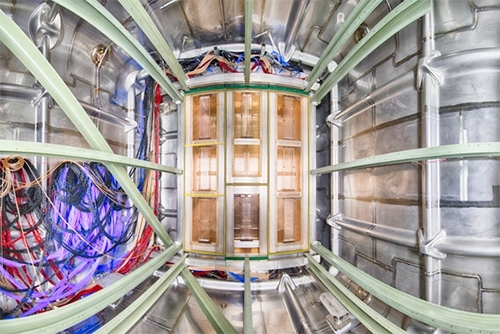

For the US particle physics laboratory, partnership with the Brazilian scientific community is strengthened by FAPESP’s support for large-scale projects such as the Deep Underground Neutrino Experiment (photo: Reidar Hahn / Fermilab)
For the US particle physics laboratory, partnership with the Brazilian scientific community is strengthened by FAPESP’s support for large-scale projects such as the Deep Underground Neutrino Experiment.
For the US particle physics laboratory, partnership with the Brazilian scientific community is strengthened by FAPESP’s support for large-scale projects such as the Deep Underground Neutrino Experiment.

For the US particle physics laboratory, partnership with the Brazilian scientific community is strengthened by FAPESP’s support for large-scale projects such as the Deep Underground Neutrino Experiment (photo: Reidar Hahn / Fermilab)
Agência FAPESP – A longstanding partnership between the Brazilian scientific community and the Fermi National Accelerator Laboratory (Fermilab) is getting stronger, thanks in part to FAPESP’s research funding programs. Recently, Fermilab, a US Department of Energy national laboratory specializing in high-energy particle physics, has issued a testimonial to this effect.
It was issued in recognition of participation by researchers from São Paulo State in the Deep Underground Neutrino Experiment (DUNE).
DUNE is an international science collaboration that seeks to discover new properties of neutrinos, elementary particles with very little mass that travel nearly at light speed. DUNE involves the construction of an underground source of neutrino beams at Fermilab.
“We’ve been funding many international collaboration initiatives, such as telescopes in Chile, the CMS and ALICE experiments at the LHC, and researchers at Fermilab,” said Roberto Marcondes Cesar Junior, who heads FAPESP’s program of Research, Innovation and Dissemination Centers (RIDCs) and is a member of the steering committee for the FAPESP Research Program on eScience & Data Science.
“FAPESP is funding some important projects relating to DUNE in São Paulo State. This is great because particle physics is a field that attracts young people, and part of FAPESP’s mission is to attract young researchers in all fields of scientific knowledge to São Paulo.”
Professors, researchers and students supported by FAPESP are involved in several experiments with neutrinos at Fermilab. Physicists affiliated with institutions in São Paulo State, for example, are collaborating with colleagues at Fermilab, Northwestern University and other US institutions to develop more accurate methods of interpreting the experimental data obtained by Fermilab’s particle accelerators. In addition to DUNE, the collaborations also involve other experiments, such as NOvA and LArIAT.
“Neutrinos will probably be part of the most important discoveries in physics for the next 10 or 20 years. We’re speaking of the most basic and important questions regarding matter and the Universe,” Marcondes Cesar said.
One of the projects conducted by researchers from São Paulo at DUNE is the light-detection system known as ARAPUCA. This is an innovative device for collecting very-low-frequency light signals from DUNE’s detectors.
“One of the challenges for DUNE’s photodetection system is that the liquid argon tanks in which scintillations will occur are very large, whereas the available light sensors are very small. In particular, the silicon sensors that will be used have a light-collecting surface area of only about 1 square centimeter. ARAPUCA’s job is to increase the collecting area and trap the photons collected inside a box for processing by the sensors,” Ettore Segreto, a professor at the Gleb Wataghin Physics Institute of the University of Campinas (UNICAMP), told Jornal da Unicamp.
Segreto’s participation in the experiment is supported by FAPESP. He has been made leader of the Dune Photon Detection System, one of the five international consortia involved in the mega-experiment.
Another participant in the work at Fermilab is Ernesto Kemp, a professor at UNICAMP. He stressed the contribution of researchers from São Paulo State to the development of technology for these experiments.
“FAPESP’s support is a key element in inserting Brazil in a proactive way into DUNE. Most of our work has always been in data analysis, and we have gradually begun to provide parts and calibration systems for detectors. Now, we’re starting to take on more important responsibilities, such as building entire systems for large-scale detectors like DUNE. FAPESP is an important funding agency because it provides long-term support for such projects,” Kemp said.
Kemp and his students have received support from FAPESP for several projects, including one that enabled him to spend a large part of 2017 at Fermilab working on R&D for ARAPUCA. During this period, he coordinated the construction of two ARAPUCA models for the ProtoDUNE detectors that are about to begin operating at the European Organization for Nuclear Research (CERN).
Marcondes Cesar also highlighted the multilateral nature of collaborations like these. “Talent is rare, and we have to compete to bring the best researchers to São Paulo. We want to bring people from abroad to do research here. We also want our researchers to make connections abroad so that they can cooperate, exchange students, and participate in international collaborations,” he said, citing FAPESP’s Young Investigator Awards program.
More information: news.fnal.gov/2018/07/strengthening-science-connections-with-sao-paulo/.
Republish
The Agency FAPESP licenses news via Creative Commons (CC-BY-NC-ND) so that they can be republished free of charge and in a simple way by other digital or printed vehicles. Agência FAPESP must be credited as the source of the content being republished and the name of the reporter (if any) must be attributed. Using the HMTL button below allows compliance with these rules, detailed in Digital Republishing Policy FAPESP.





